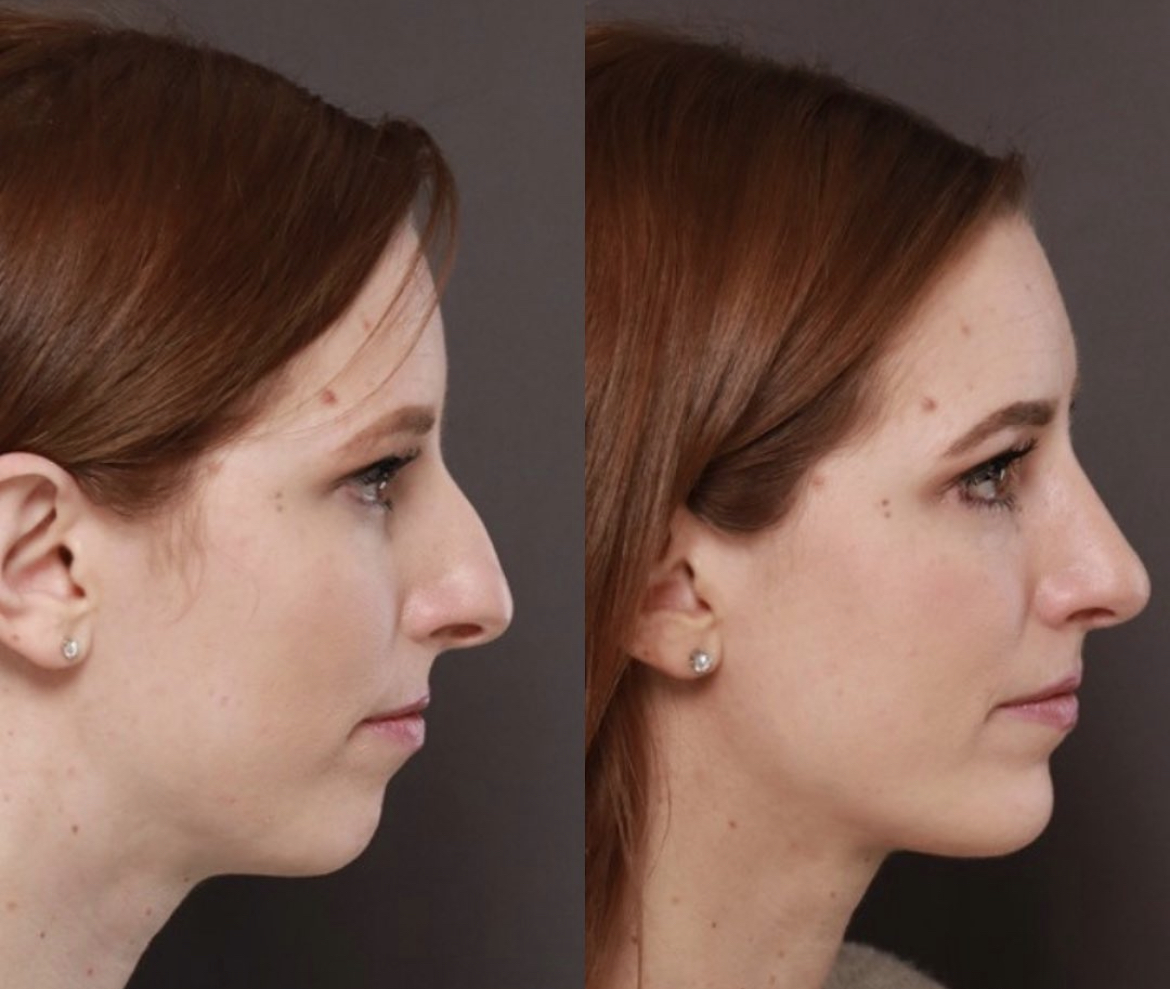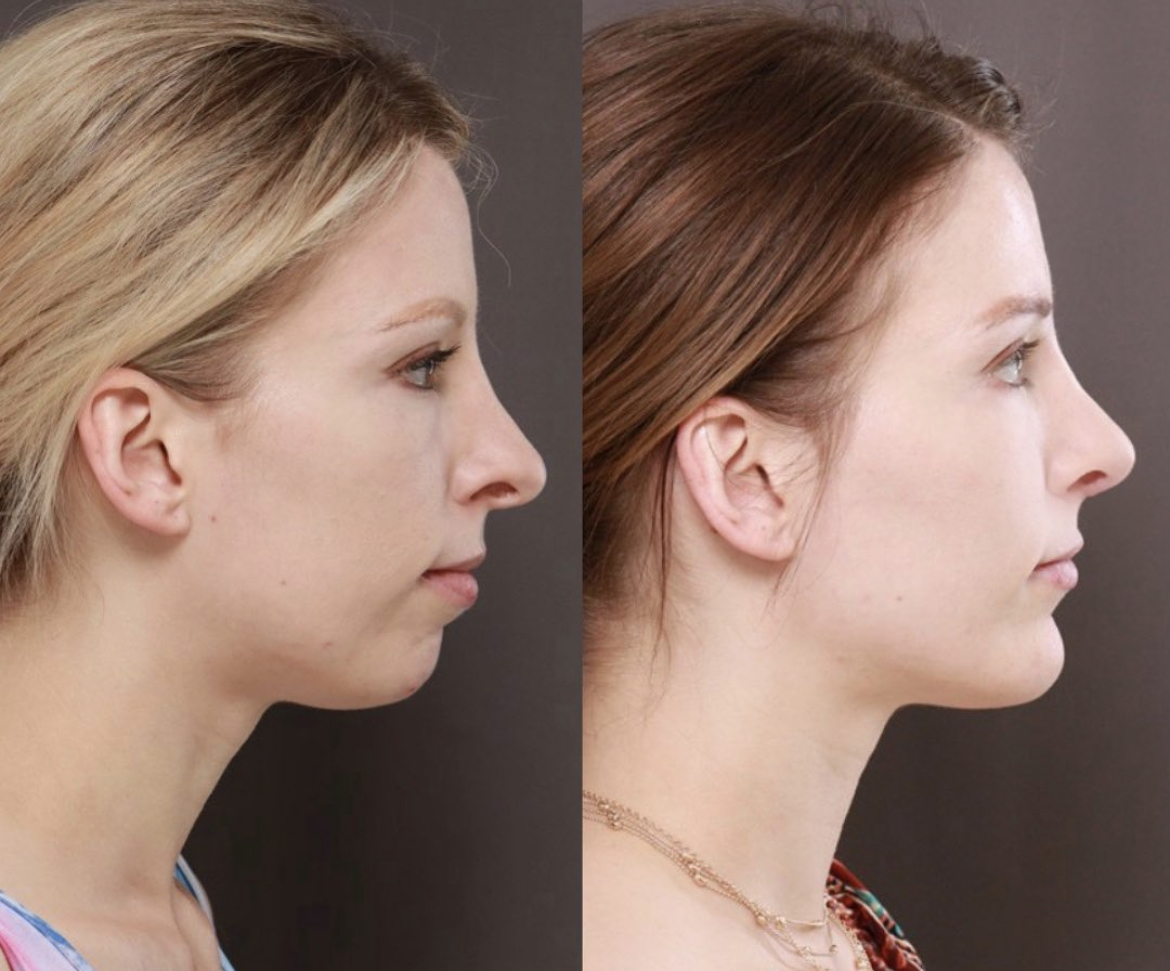What is chin augmentation (Chin Implant Surgery)?
The skeletal structure of the lower face, including a strong jaw line, contributes greatly to overall facial harmony and aesthetic balance. A small chin can make a normal-sized nose seem overly large and can also blur the distinction between chin and neck. When the chin is small and the teeth are not aligned properly, consultation with an oral surgeon may be necessary. However, generally speaking, in appropriate candidates, a weak chin can be effectively augmented with a chin implant
Chin implants come in various sizes and shapes individually suited to each patient’s unique anatomy. A commonly used implant adds projection to the chin to strengthen it but also adds supports under the marionette lines to soften jowls. For patients without jowling, an implant that adds only to the projection and strength of the chin may be appropriate. Finally, some implants are designed specifically to soften the jowls only if patients do not want to add to the projection of their chin.
Who Is A Candidate For a Chin Implant?
Candidates for chin implant surgery typically include individuals who are dissatisfied with the size, shape, or projection of their chin and desire a more balanced and harmonious facial profile. Here are some common reasons why someone might consider chin implant surgery:
- Weak Chin Profile: Individuals with a receding or weak chin may opt for a chin implant to create a more defined and balanced facial structure.
- Facial Harmony: People who feel that their chin is not in proportion with the rest of their facial features may choose chin implant surgery to achieve better overall facial harmony.
- Aging: As people age, the chin and jawline may lose definition. Chin implants can help restore a more youthful appearance by providing better chin projection.
- Reconstructive Purposes: In some cases, chin implant surgery may be recommended for reconstructive purposes, such as correcting congenital defects or injuries.
Chin Augmentation Before & After Photos
Can Chin Augmentation Be Done With Other Procedures?
Chin implants can complement a variety of other surgeries and procedures. Here are some examples:
Rhinoplasty: Evaluating the balance of the profile is important for every rhinoplasty patient. A large nose can blend well with the facial profile if the jawline and chin are strong. Alternatively, even a smaller nose can appear too long if the chin is small. Adding projection to the chin can help to balance the profile of the upper, middle, and lower thirds of the face.
Facelift: As we age, we lose volume in the bone of the jaw. One of the key places affected by this is the bone under the marionette lines or jowls. This deepens the creases in the skin and makes the jowls more prominent. Chin implants help to restore bony volume loss under the marionette lines to soften the crease and reduce the jowls. Many patients are looking to deepen their neck angle with a facelift. Adding strength to the chin lengthens the jawline and deepens the space from the chin to the angle of the neck.
Deep Neck Contouring: Many younger patients looking to deepen their neckline benefit from strengthening the jawline with a chin implant. This is because adding strength to the chin lengthens the jawline and deepens the space from the chin to the angle of the neck. Additionally, some younger patients have already started developing jowls and a chin implant will help support the skin under the crease in front of the jowls to reduce their appearance.
Buccal Fat Reduction: Buccal fat sits just to the side of the corner of the mouth. For some patients, this fat is enlarged, contributing to fullness in the cheeks. Removal of that fat can help give definition to the cheekbones and jawline. If the chin is small or the jawline is weaker, a chin implant can help accentuate the slimming of the cheeks while also defining the jaw.
Chin Implant FAQs
In Utah, most standard chin augmentation procedures cost anywhere from $3000 to $6000. This may or may not include other fees such as anesthesia or facility fees.
Although cost is important, it is much more important to do your research on the physician and facility who will be doing your procedure. UFP surgeons are double board-certified ENT and Facial Plastics, having specialized experience in procedures of the face and neck. This type of training and expertise will improve your overall experience and lessens the chance of complications. Visit on of our experts for a chin implant consultation to discuss your goals and an individualized quote will be given to you at that time.
Chin implant surgery can be done in the office or operating room. We often do chin implants alone under local anesthesia in the office, it truly depends on the individual.
Prior to your procedure, a chin implant style and size will be discussed between you and your surgeon. After anesthesia is administered, the surgeon will create an incision under the chin area and create a space for the chin implant to be placed. The surgeon will then use sterile "sizers" to confirm the suggested implant style and size before placing the actual chin implant. Once the chin implant is sutured into place, the underlying tissues and incision are sutured back together.
A post care bandage is placed on the incision and the sutures are then removed in 5-7 days. Swelling, bruising, and tenderness may occur and it can take several weeks or months for numbness and normal feelings to return in this area. You will visit your surgeon for a series of follow up appointments to monitor healing.
If a patient opts for a chin implant made from silicone, they should expect their procedure to last a lifetime. With that being said, there are always risks of complications like displacement or the patient not being satisfied with the changed look. Fortunately the chin implant can be removed if desired.
A strong chin balances your lower face with your forehead and nose. A small chin can make your nose look large and a short chin, when viewed from the front, can make your face look top heavy. The chin also plays a critical role in setting up the balance between our face and neck. A stronger chin deepens the angle of the neck, helping to create a sharp junction at the point where the jawline meets the neckline. Chin implants also help resolve a witch’s chin (ptotic chin). This occurs when the chin drops below the bone of the chin, making it seem like the chin is hanging from the front of the face. This can also be corrected with a chin pexy in patients who do not need to increase the projection of the chin.
Any time you make an incision on the skin, there will be a scar. The incision for the chin implant is about 1.5 cm in length and it is placed in the wrinkle under your chin. The scar ends up being a thin line that hides in the depth of the wrinkle making it nearly imperceptible.
It is very common to have temporary numbness of the chin and lower lips in the early stages of healing. This resolves with time. Rarely would a patient have long-term decreased sensation of their chin after surgery
Infection of the implant is another very rare complication that can occur. We place in implant through an incision under the chin rather than placing it through in incision inside the mouth to help prevent infection of the implant. The implants are also placed in a sterile fashion taking great care to not introduce any bacteria into the implant pocket.
Migration or malposition of the implant is prevented by forming a tight pocket to hold the implant securely against the bone at the time the implant is placed.
The best way to know which implant will complement your features is to discuss your goals and anatomy in consultation with one of our surgeons. We can perform imaging to show you what an implant would look like using your own photos.
Many materials exist, but the most commonly used implants are made of silicone. The silicone is solid but flexible. This allows it to be placed through a small incision under the chin. It is fitted under a tight pocket against the bone and once in place, it looks and feels like it is part of the jaw. The implant is held securely by the tight pocket against the bone and sutures are placed to further secure it.
Chin implants can be placed in about a half hour to one hour and many patients choose to have it done without general anesthesia. The area is numbed and patients are then comfortable throughout the procedure. General anesthesia can be used if patients prefer or if the implant is being placed at the time of another surgery requiring anesthesia such as a facelift or rhinoplasty.
The chin is sore and swollen for the first week after surgery, then begins to taper down. The profile of the jaw is improved immediately but the jaw may seem somewhat wide from the front view for the first few weeks as the swelling resolves. There is often bruising around the jawline that can be covered with makeup immediately after surgery, as long as the incision line is avoided. Strenuous physical activity should be avoided for 3 weeks after surgery.
There are pros and cons to both chin implant or chin filler. It is best to have an in depth consultation to discuss your concerns, goals, and what each treatment entails.
Chin implants are a more stable treatment, they are meant to be more of a permanent option, but they can be removed. They create more structure and definition.
Chin filler is used to add volume and structure, and is most commonly done with a hyaluronic acid filler. These types of fillers do break down over time, so the treatment will need to be repeated over time. On average chin filler lasts up to 9 months or longer.
Chin Implant/Augmentation Resource Guide
Call Utah Facial Plastics for your Chin Augmentation!
Be sure to give us a call at 801.960.3137 if you wish to learn more about chin implant surgery, or if you wish to determine whether you are a candidate for the procedure. You can also fill out our consultation request form, and our staff will help you set up an appointment with our experienced facial plastic surgeons. Our practice has two offices in the Salt Lake City area, in Draper and Layton respectively.


